This isn't your ordinary chicken soup recipe, but it's delicious! When you serve it to your friends and family they will think they are eating at a delicious Thai restaurant and you don't have to tell them how little effort it takes to make it!
Coconut Chicken Soup is also known as Tom Kha Gai soup and is a very popular Thai soup that only looks complicated to make!
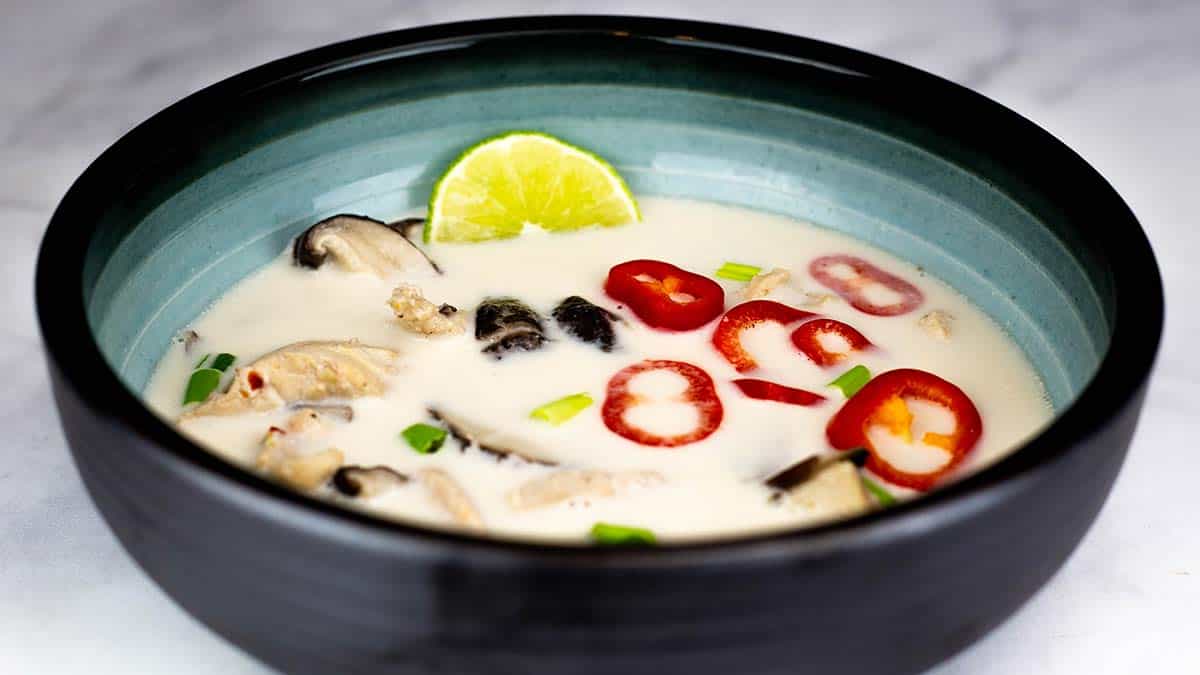
Don't worry if you don't have all the traditional ingredients, there are tons of ways to make this soup with easily accessible ingredients and I walk you through all of it in the Ingredients & Substitutions section.
You can make it on the stove, slow cooker or, my favorite way, in an electric pressure cooker. I use the Ninja Foodi Pressure Cooker & Air Crisper in this recipe, but you can use your Instant Pot.
While my base version is a traditional Thai Coconut Chicken Soup, I decided not to name the recipe Tom Kha Gai because the name translates to Tom ( to boil) Kha (galangal) Gai (chicken) and I don't want anyone to miss out on this soup just because they can't find galangal, so calling it Coconut Chicken Soup leaves a lot more room for substituting ingredients and making the soup your own.
I always do! I love putting a few spins on the traditional version by adding extra veggies for a hearty coconut chicken vegetable soup.
Suggested Kitchen Tools
- Electric Pressure Cooker or a Large Pot
- Sharp Knife
- Cutting Board
Ingredients & Substitutions
The main ingredients in this soup are easy to find at most grocery stores, but there are a few specialty items that can be found at International Food Markets or you skip them and the coconut chicken soup will still be delicious.
Please look through this section for all the information needed on the various ingredients and what can and can't be substituted for the best outcome when making this delicious soup!
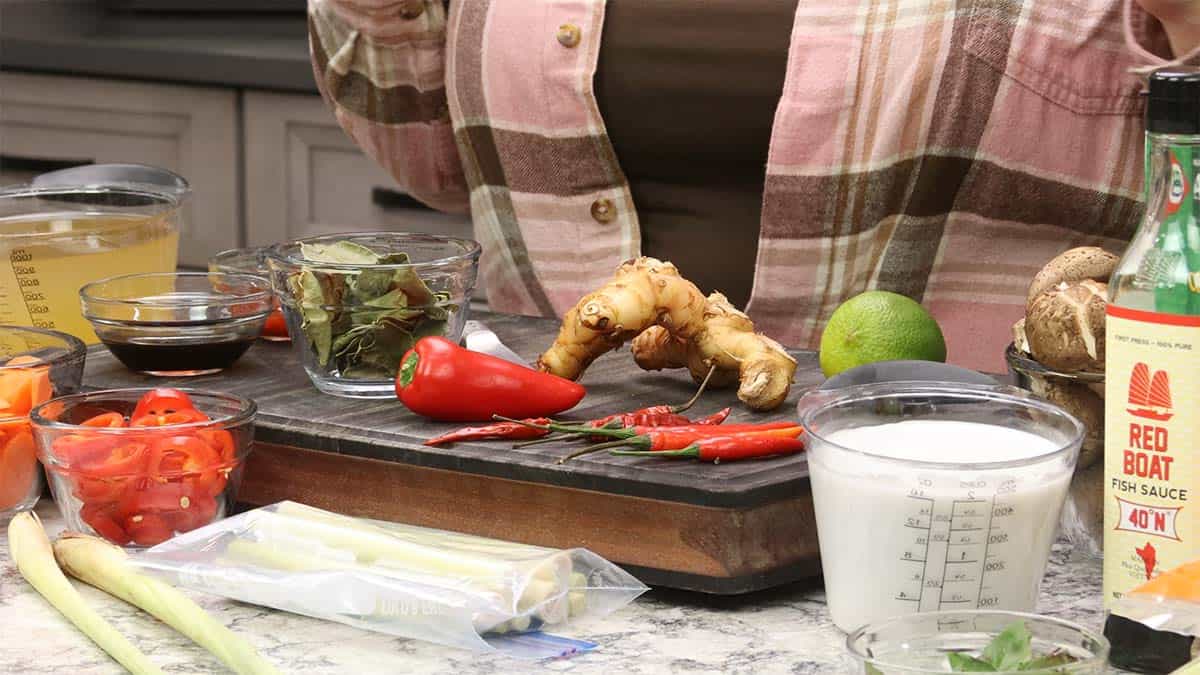
Chicken
You can use any cut of chicken in this recipe. I prefer using chicken breasts, but if you have a whole chicken you could cook the aromatics and broth with the whole chicken (your cooking time would be longer of course). You would want to decrease your chicken broth to 1-2 cups because the whole chicken will give off lots of juices.
Another option is using skinless, boneless chicken thighs. You won't need to adjust the timing if substituting thighs for breasts if you cube or slice the thighs.
The chicken can be frozen or thawed. If you want to cook whole chicken breasts that are frozen, increase your pressure cooking time to 12 minutes. Then you can remove the chicken and cut it up as desired.
You can slice the chicken, chunk the chicken, or even shred the chicken depending on what kind of texture you want in your soup.
I like to thinly slice raw chicken and it helps if it is partially frozen to get really thin slices which results in really tender chicken with a great texture for the soup.
You can also use leftover Rotisserie chicken or precooked chicken in this recipe. You will want to add the cooked chicken after you pressure cook the broth and aromatics.
If you wanted to skip the chicken, shrimp would be great to add at the end and you would have a coconut shrimp soup.
Liquids
The main liquids in this recipe are chicken broth and coconut milk.
Chicken Broth: You can certainly use chicken stock or vegetable stock in place of the chicken broth if you want a vegetarian version.
Coconut Milk: The type of coconut milk you use is going to be in can or a carton in the dry goods section of your grocery store. It is not the kind you find in the dairy section. The coconut milk we use in this recipe is a combination of coconut liquid and coconut cream. You may get a can where the cream is separated from the liquid and that is perfectly fine. You can whisk it before adding it to the soup and it will come back together easily.
I did quite a bit of research when developing this recipe and one recommendation was to use coconut milk in cartons if you can find it. I went to the K&S World Market in Nashville recently and found coconut milk in the carton and I was very pleased with the outcome of the soup. It had a more pronounced coconut flavor and enhanced the soup quite a bit. The creamy coconut milk in the carton had a more homogenous appearance and luxurious texture. However, I have made the recipe with canned coconut milk many times and it is also delicious.
There really isn't a substitute in this recipe for coconut milk, it is a major ingredient for providing the correct flavor. I do recommend using full fat coconut milk, but you can use light coconut milk if you prefer.
Aromatics & Seasonings
Coconut Chicken Soup doesn't have a lot of ingredients in it, but each one plays a role in the flavor development. While it is okay to omit or substitute ingredients based on what you have access to and your dietary restrictions or preferences, each change will impact the overall flavor a bit. If you make too many substitutions to the aromatics and seasonings you may find the Thai chicken soup lacking in flavor and depth.
Lemongrass
This is one of my favorite flavors in Thai cuisine and before I was able to find fresh lemongrass I had to use lemongrass paste found in the produce section of my local grocery store.
When I moved to Tennessee it was even hard to find the lemongrass paste so now I make the drive to Nashville every few months to buy and process fresh lemon grass. If you live in a fairly populated area, you should be able to find fresh or prepared lemongrass paste fairly easily.
Many times major grocery stores like Kroger, Whole Foods, and even Walmart will carry lemongrass stalks in the produce section where they have the packaged fresh herbs.
How to Prepare Fresh Lemongrass
If you are able to get whole lemongrass stalks, they are simple to prepare for use in cooking. They also freeze beautifully.
The whole stalks are quite long, 18" is quite common. The usable portion is going to be about 6-8" usually. It is found about 2-3" above the bulb end and 6-10" from the green stalk end.
Once you cut off both ends, simply peel the outer layers of the stalk until you reach the light colored interior. This is what you will use in the soup.
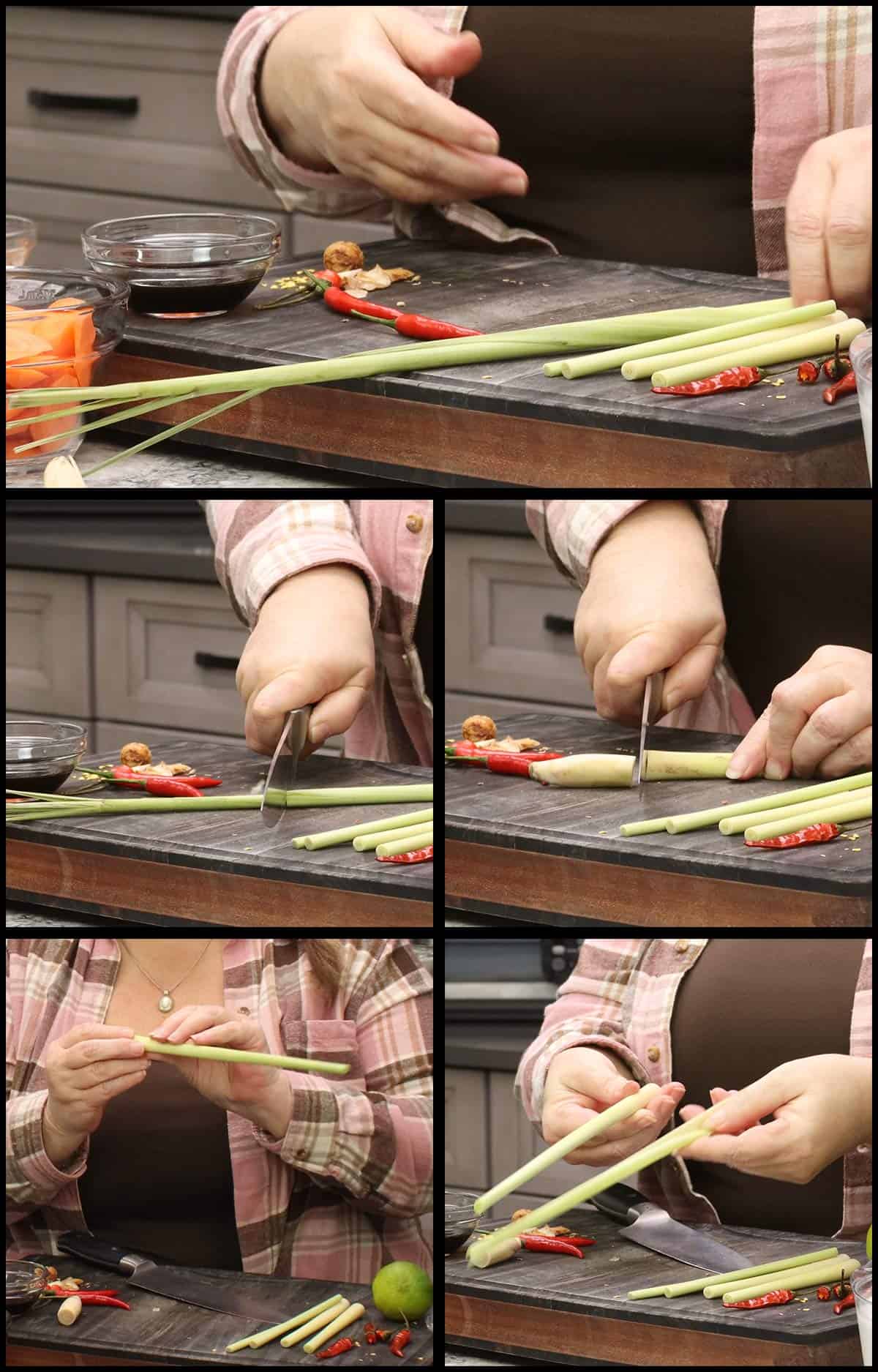
You can slice it thinly, but I find it unappealing in texture to eat so I leave it whole and gently pound it or break it open some to allow the flavors to infuse into the soup and then I remove the lemongrass before serving.
Substitutions for Lemongrass
While nothing is a direct substitute for lemongrass, you can try adding a little more lime zest and juice to the soup after cooking if you think it needs a boost of citrus to balance it.
Fish Sauce
This is one of those ingredients that I often hear people not wanting to use because they don't like fish or think they won't use it except for in this recipe. Please use it. The soup is not the same without it.
I do not like fish that much and this sauce stinks to me to the point where I never wanted to use it, but the effect it has on the depth of flavor in so many Asian dishes is amazing. If you enjoy Asian food, you will use it and it stays good in the fridge for a long time. It is easily found at most grocery stores.
If you absolutely can't have fish sauce, you can try using soy sauce or coconut aminos as a substitute. These aren't exactly the same and the flavor won't be as rich, but it's better to use one of these than not replacing the fish sauce with anything.
Kaffir lime leaves
This is another ingredient that you may have trouble finding if you don't have an Asian market near you. I have never seen fresh, frozen, or dried in any grocery stores near me. You can pick up (affiliate link)dried kaffir lime leaves on Amazon.
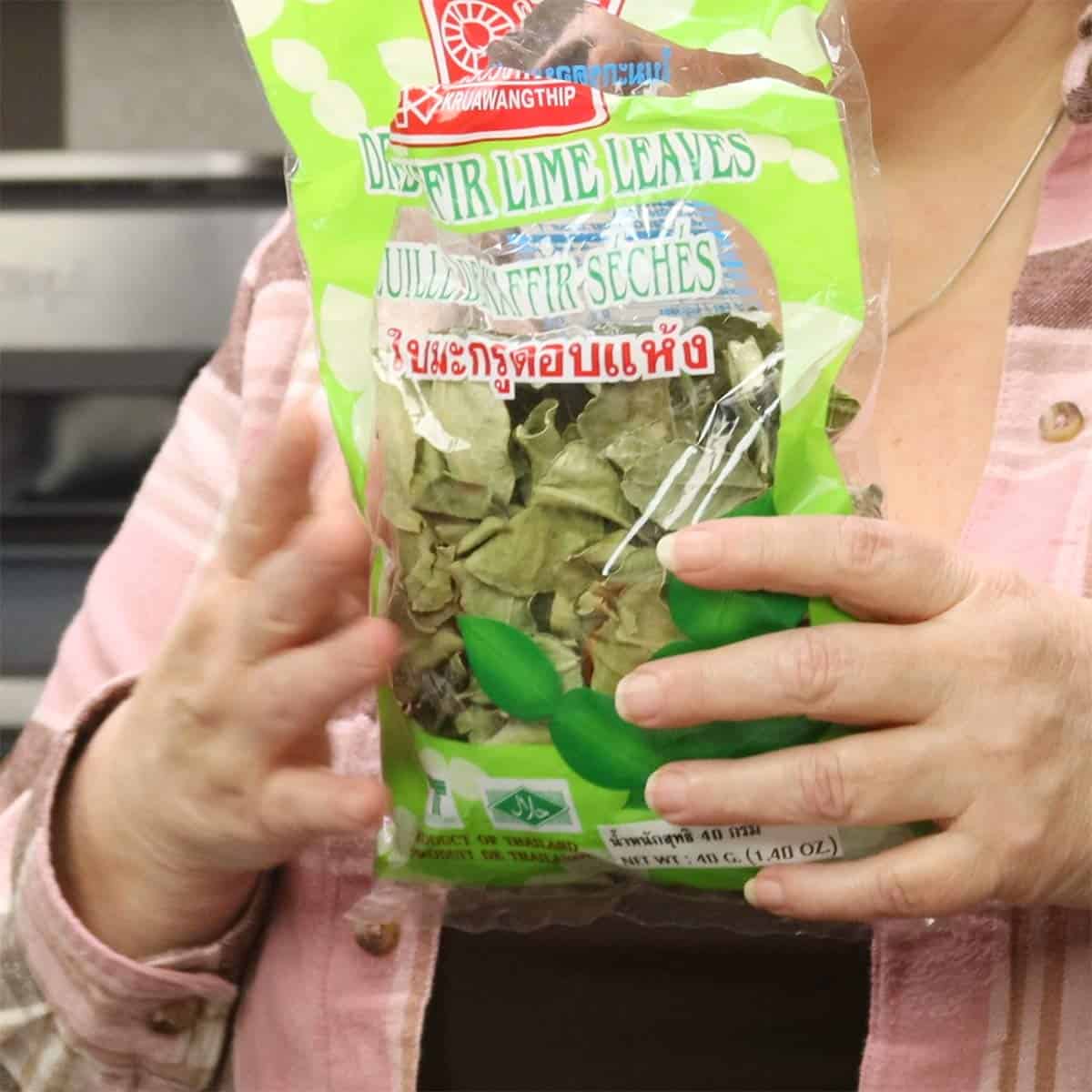
The amount of Kaffir lime leaves you use in the soup is the same no matter if they are dry, frozen, or fresh and I don't have a set rule on how many to use. I usually use anywhere from 4-8 depending on their size. I have also made this tom kha gai recipe without the Kaffir lime leaves and it was delicious. So, this is one of those ingredients that doesn't have a good substitute, but you can skip it in the recipe if you can't find it.
Galangal Root
This one is probably the most difficult to find and if you cannot find it, just skip it. Some people recommend using fresh ginger in its place, but galangal and ginger do not provide the same effect on the soup.
Ginger is spicy and sharp, while galangal is fresh, slightly citrusy, and piney at the same time. It is one of the most unique aromatics that I have cooked with. Galangal is used in this soup as an aromatic and infuses flavor, but is not necessarily eaten as part of the soup because it is very fibrous and tough.
Some people will thinly slice the galangal, but I prefer larger chunks so I can easily find and remove them from the soup before serving. You don't want your guests to bite into one, it is too hard.
At first glance the galangal root looks a lot like ginger, but it is much harder. You do not have to peel the galangal before putting it in the soup, but I do like to take off the knotty spots on the root and then slice it into small pieces.
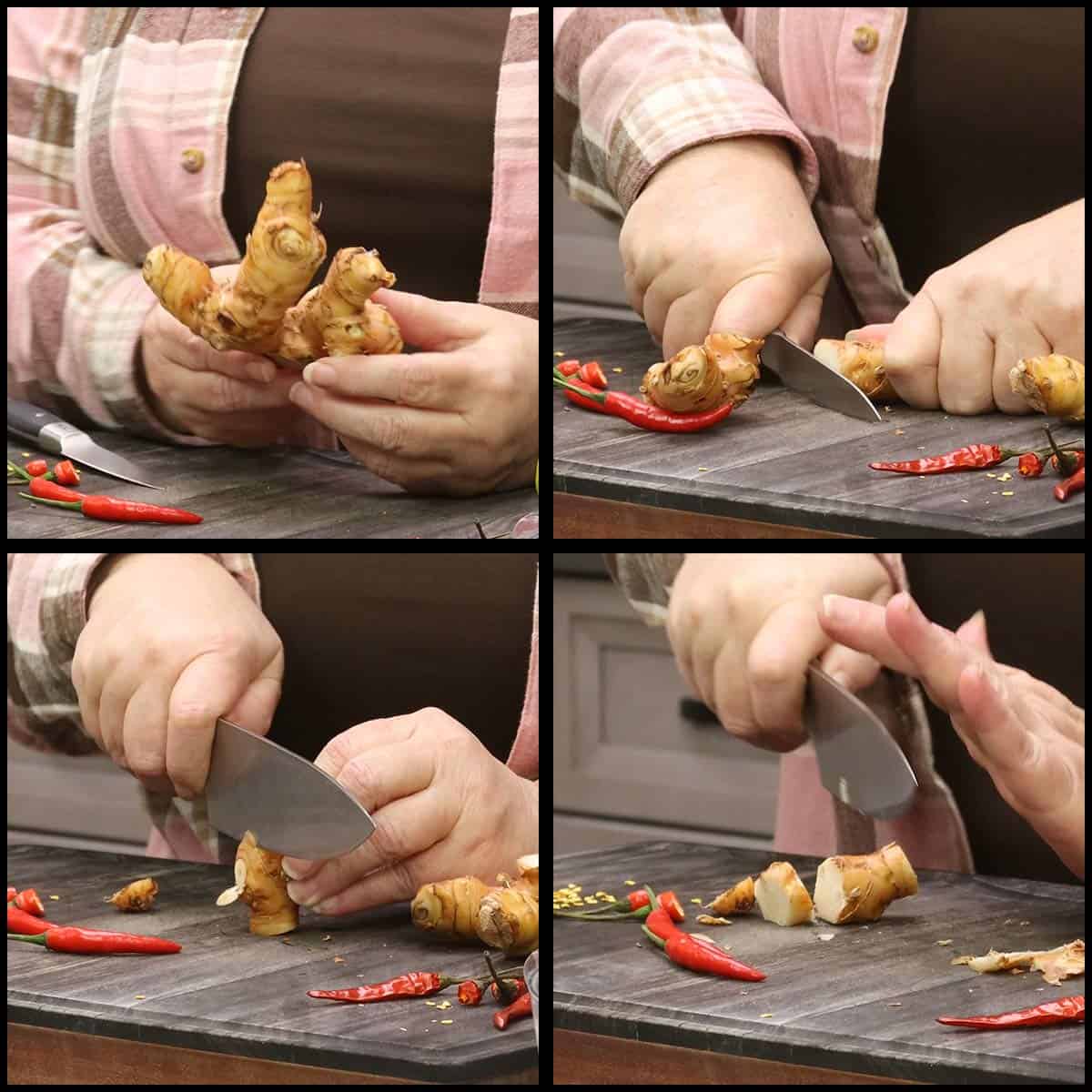
Don't worry if you can't find it, though; I have made the soup many times without it and it turns out just fine.
Lime
In addition to the Kaffir lime leaves, regular limes that you find at the local grocery store are also used. I use the zest and the juice from 1-2 limes after the soup is finished.
This burst of lime flavor brightens the soup and adds the perfect balance. Start out with the zest and juice from one lime and then give the soup a taste. Add more lime if desired.
Thai Chili Peppers & Garlic Chili Paste
These are the two ingredients that add spiciness to the soup and since you are making it, you control the amounts!
It is perfectly fine to skip both of these ingredients for a mild soup. As the recipe is written, I would consider the spice level a 6 on a scale of 1-10.
You can use dried or fresh Thai Chili peppers and simply cut off the stem and add them to the soup or remove the seeds for a slightly less spicy soup.
The (affiliate link)chili garlic sauce I use is easily found in most grocery stores or on Amazon.
You can substitute the for chili garlic sauce with (affiliate link)sambal oelek and the only difference is the garlic. Either skip the garlic or add in 1-2 cloves minced.
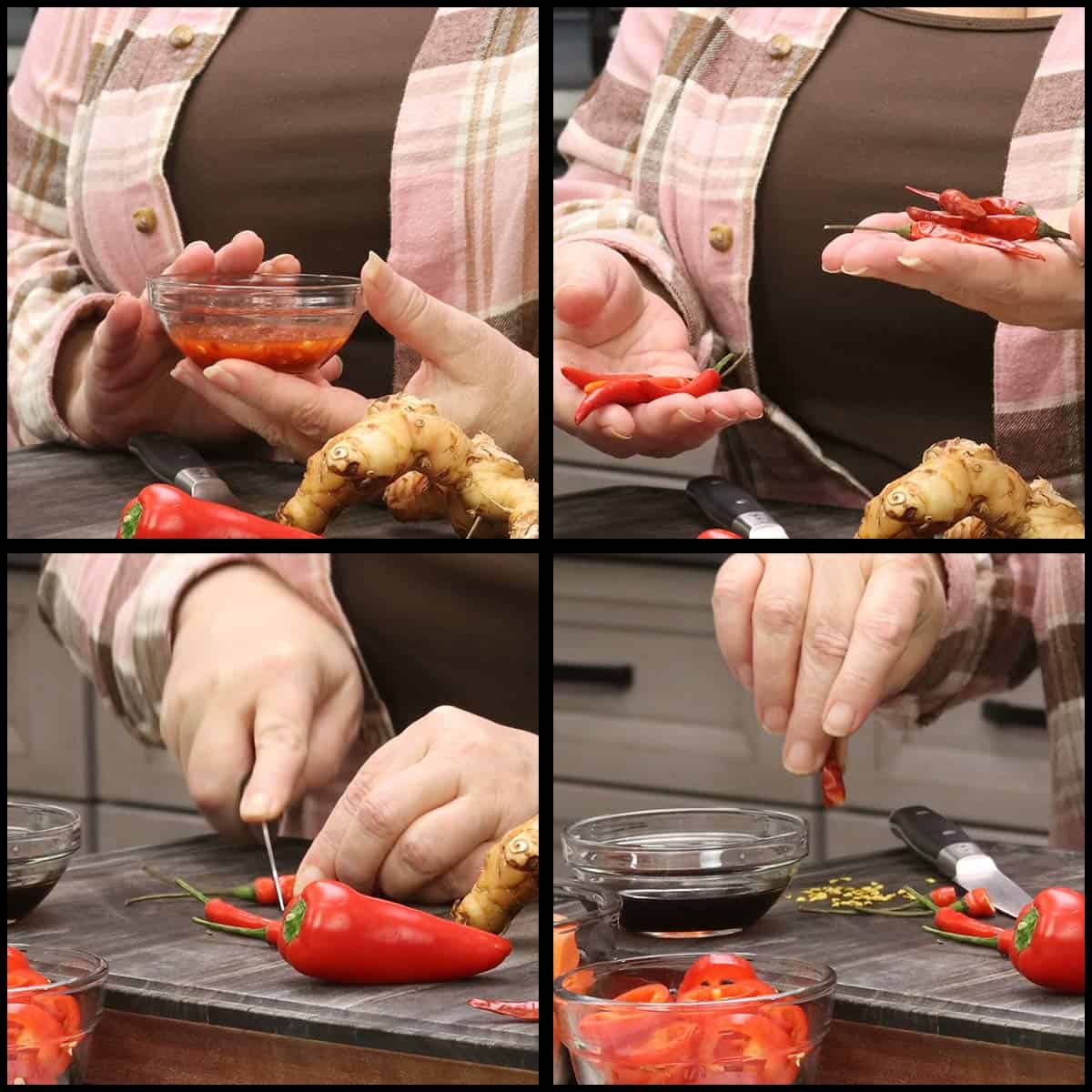
Vegetables
Mushrooms are a standard in Tom Kha Gai soup and you can use whatever kind you like or can find.
I used a combination of fresh Shiitake mushrooms and Baby Portabello mushrooms in my recipe, but I have also used all Portabello when I can't find Shiitake.
If you are going to use dried Shiitake Mushrooms, make sure they are rehydrated fully before adding them to the soup. The short pressure cook time isn't enough time to fully hydrate them and they turn out chewy.
You can increase the pressure cook time if you want to add them in dry and see if they hydrate and soften enough. However, in my experience, it is better to soak them in water to hydrate before using them in soups.
Carrots are not traditional in this soup, but my favorite Thai restaurant always adds them to their Tom Kha Gai along with other veggies and I love the heartiness that these extra vegetables add to the soup.
The carrots should be added after the soup pressure cooks and then simmer the soup until they are just cooked enough not to be raw and hard. You want them firm in the soup for texture.
Sweet Red Peppers are another great vegetable choice and add wonderful color to the soup. These can also be added in after pressure cooking and simmered just until they soften, but still retain their vibrant red color. This addition adds interest to the soup by adding color and also texture.
Other Vegetable Choices
When making your coconut chicken soup, you are the boss. Add whatever veggies you love and leave out those you don't. Some other options I've tried and enjoyed are:
- Chopped Zucchini
- Small Broccoli Florets
- Spinach
- Cauliflower
- Bamboo shoots
Optional Ingredients and Garnishes
I will also add a little sugar sometimes if I feel the soup needs some sweetness, but that is very rare.
The garnishes I use depend on what I have on hand, but my favorites are:
- Chopped Green Onions
- Fresh Thai Basil
- Fresh Cilantro
How to Pressure Cook Coconut Chicken Soup
Mise En Place
This soup is quick to make if you have all of your ingredients prepared and measured out. Please refer to the Ingredients & Substitutions section if you need to know how to prepare the lemongrass or galangal.
- Pound or break the lemongrass stalks
- Cut the galangal root into small chunks
- Cut the ends off of the Thai chili Peppers
- Slice the chicken
- Slice the mushrooms
- Measure out the remaining ingredients
Pressure Cook
You don't need to sauté anything, so this soup is very quick to make using the pressure cooker and you can infuse all the flavors in less time than when making it on the stove.
Quick Tip
You can put the kaffir lime leaves and galangal in a sachet pouch like you would use for infusing herbs to make it easier to remove them at the end of cooking.
Add the chicken broth, chunks of galangal, kaffir lime leaves, Thai Chili peppers, chili garlic sauce, lemongrass, and fish sauce. Don't skip the fish sauce!
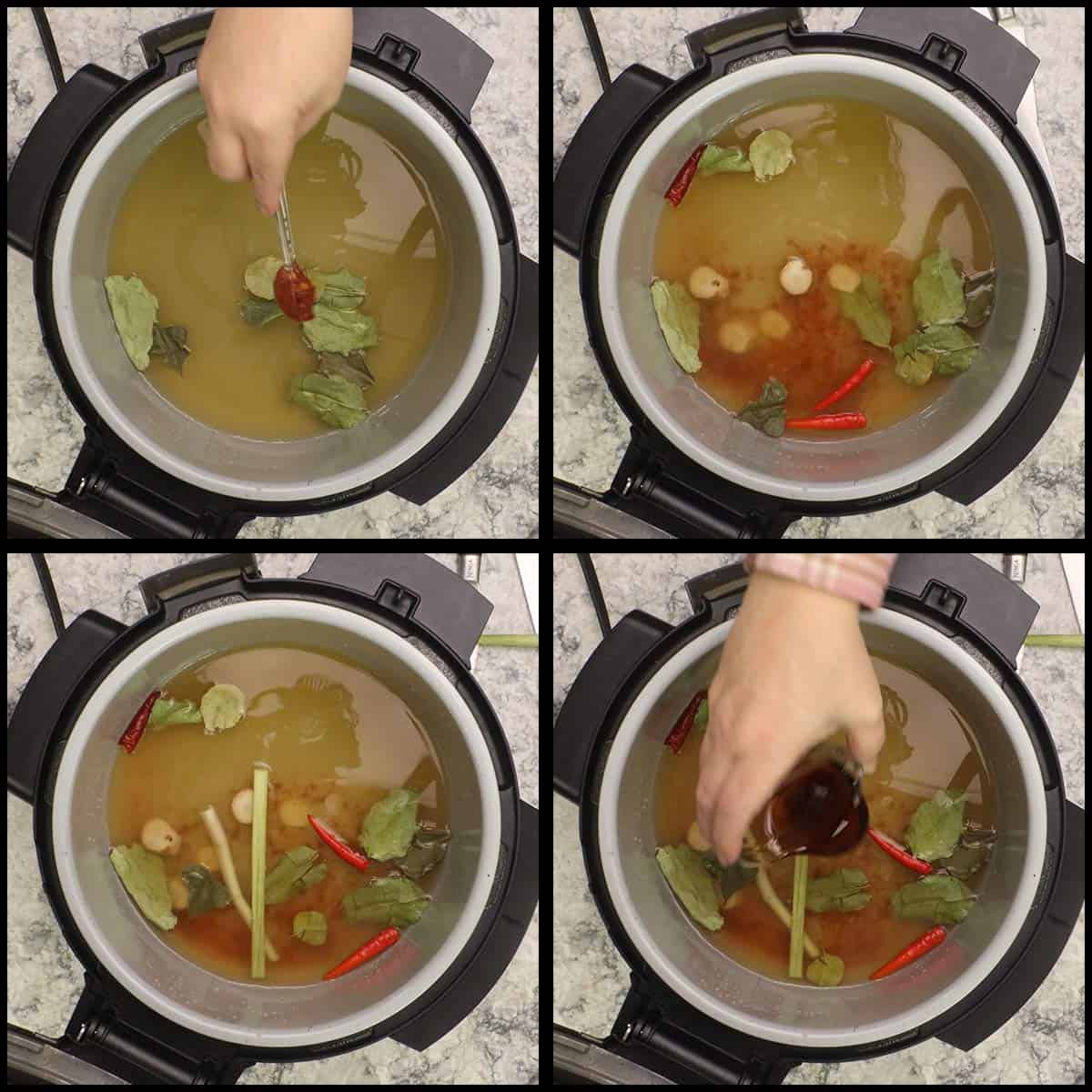
Next, add in the sliced mushrooms and sliced chicken along with the salt.
Make sure to stir everything and break up the chicken slices the best you can. If they are all in one clump, they will cook in one clump and be harder to get apart when the pressure cooking is complete.
Put the pressure lid on and make sure the valve is sealed. Set the pressure function on high and the time for 2 minutes. Press start.
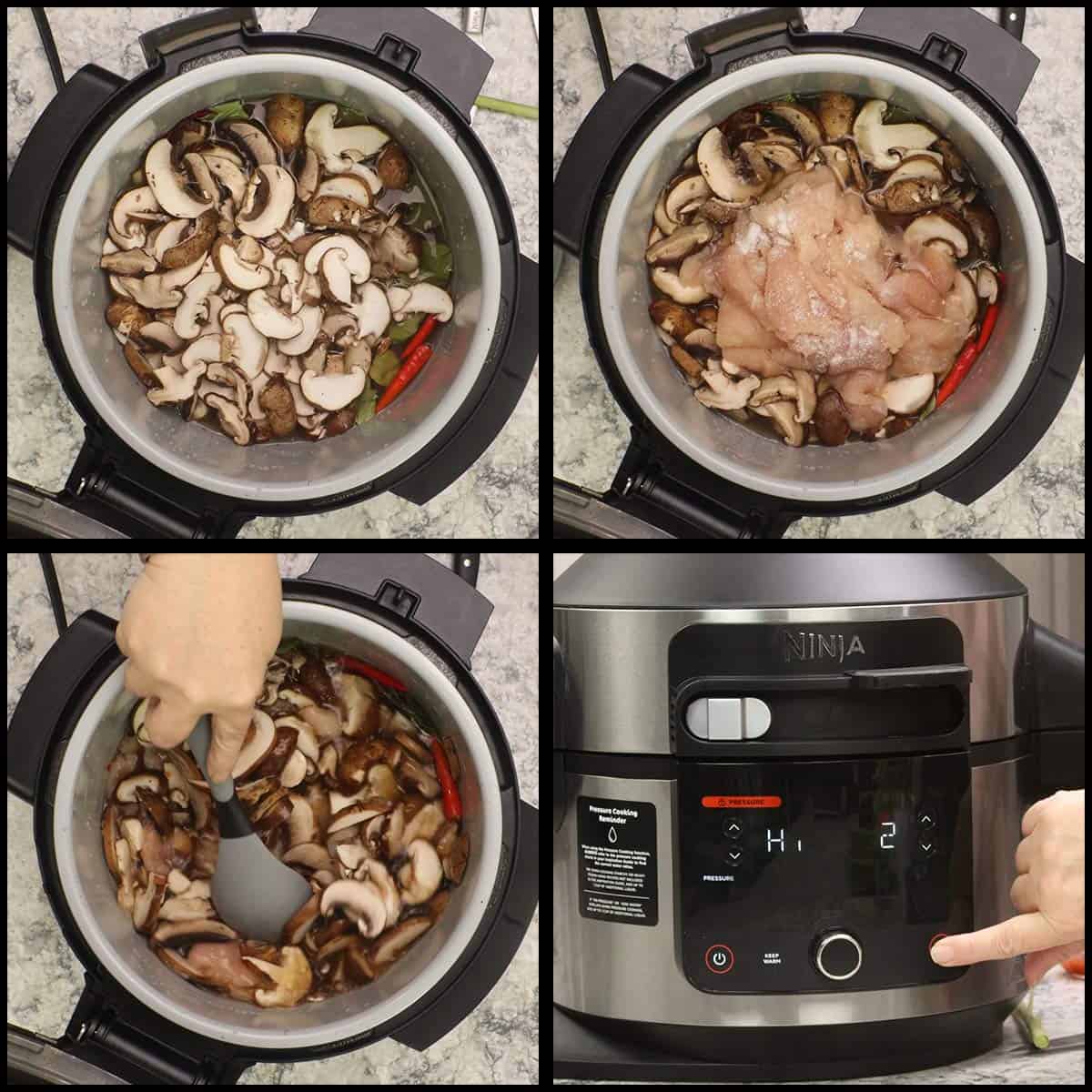
The time to pressure will be about 8-12 minutes on average, but if your chicken is partially frozen, it may take longer.
Once the pressure cook time is up, you can immediately release the pressure.
Don't panic when you open the lid, it doesn't look beautiful right now. It will, though; I promise!
The first thing you want to do is break up any chicken that may have clumped by stirring the soup really well.
Quick Tip
If your coconut milk has separated in the can, give it a good whisk or blend it in the blender so it is a smooth consistency when added to the soup.
Then add in the coconut milk and stir. I used 2 cups of coconut milk, but if you are using the canned variety that is around 13 ounces per can, just use one can and it will be fine.
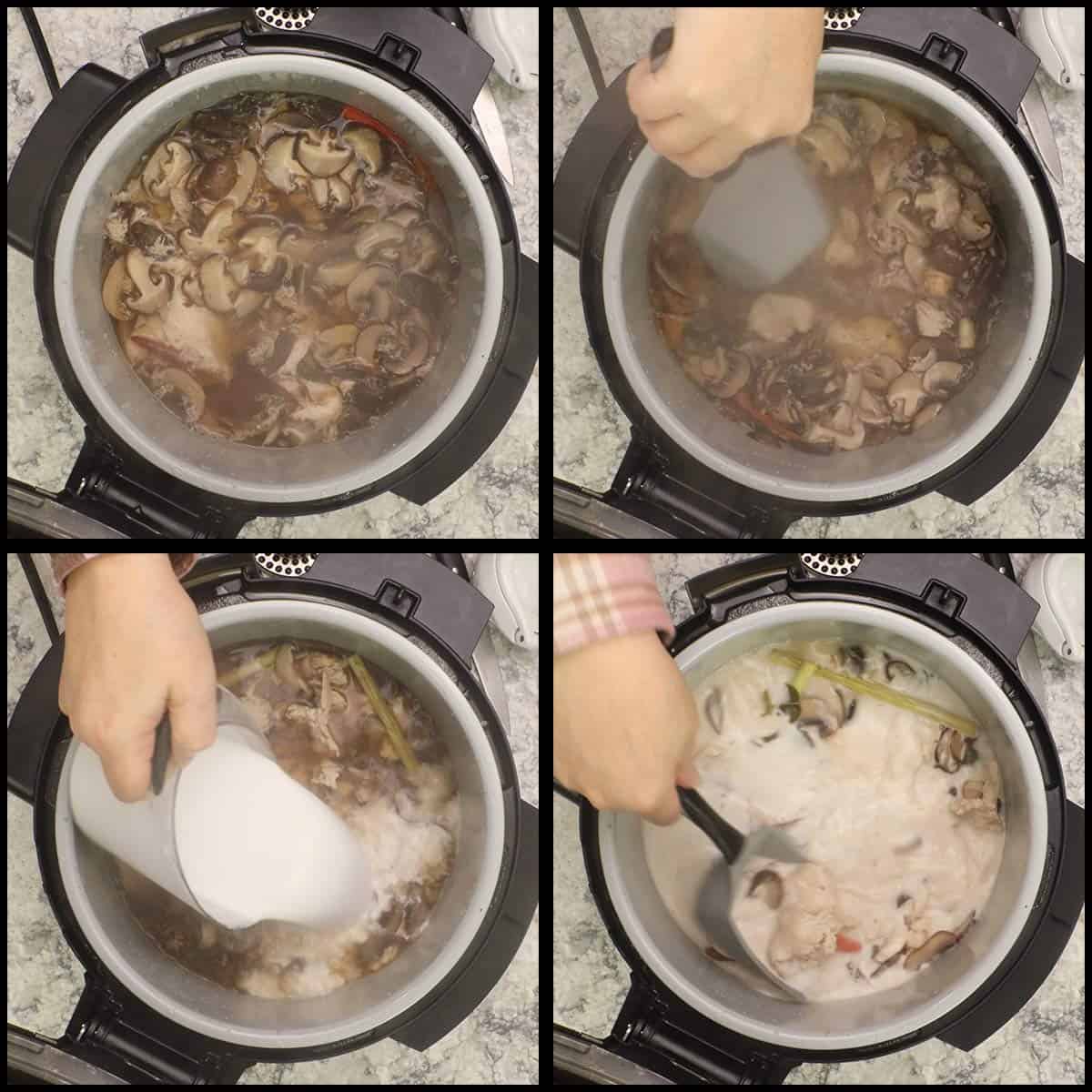
Stir well to incorporate the coconut milk and if you are going to simmer veggies, turn the Ninja Foodi on sear/sauté on heat level 3.
Add Final Ingredients to Simmer
Depending on what you want to add to your coconut chicken soup, this step could simply be zesting and juicing the lime and giving everything a good stir and taste before serving.
Since I like to add a few veggies, I will be adding those and simmering the soup for 5-10 minutes until they are cooked to my liking, which is firm, but not raw for the carrots and peppers.
The amount of lime you use is up to you. Start with the zest and juice from 1 lime and then taste the soup. If it tastes good and is balanced nicely, stop there. If it tastes a little too rich or flat, add in some more zest and lime juice until it tastes perfect to you!
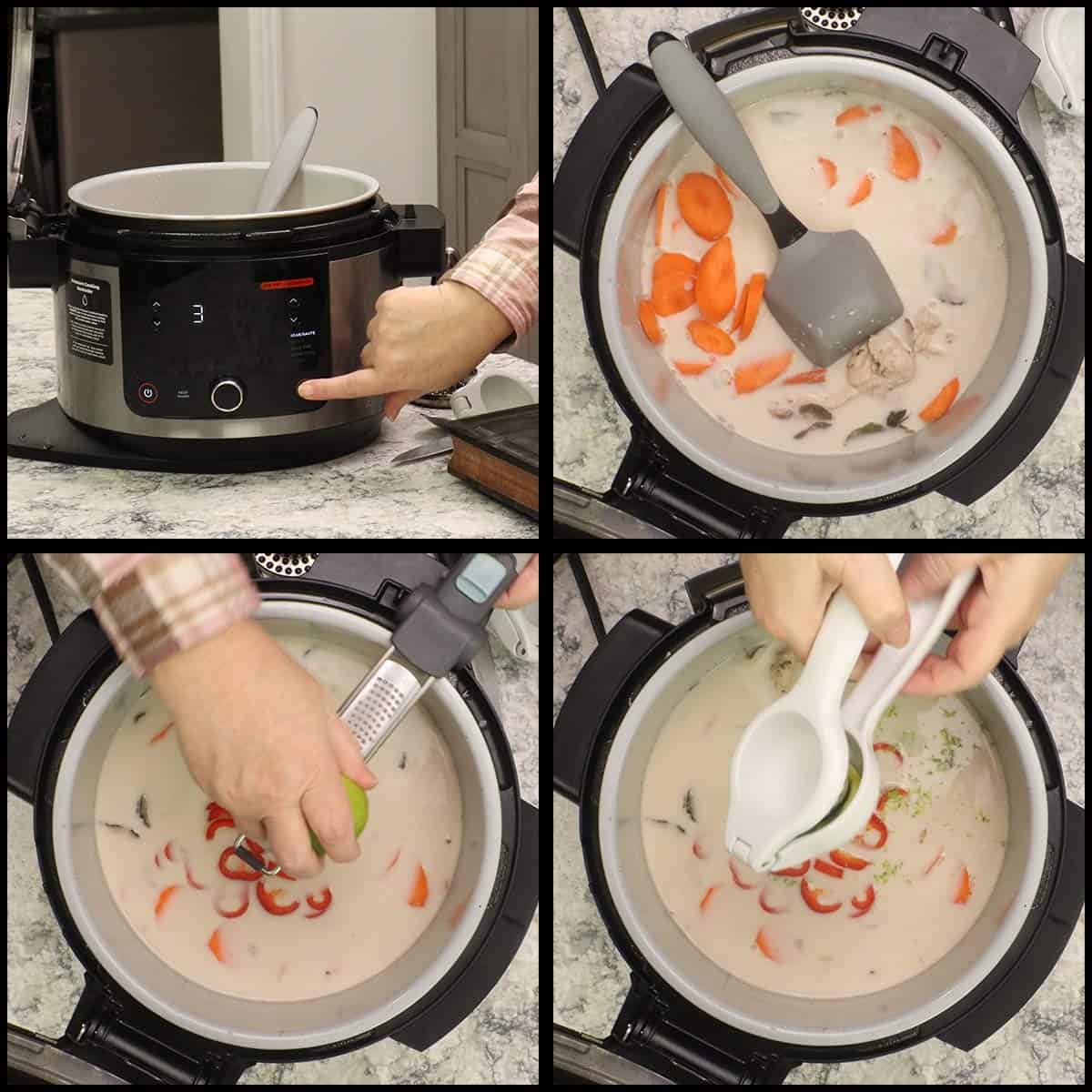
Once the added vegetables are cooked the way you like them, you are ready to remove the aromatics and add any extra garnishes.
Final Touches
Just before serving, you will want to remove the aromatics from the soup. This includes the dried lime leaves, lemongrass stalks, and the galangal chunks.
Quick Tip
Leave the aromatics in the soup if you plan on reheating it the next day. They continue to add flavor.
The easiest way to remove them is with a large scoop if you didn't put them in a sachet pouch.
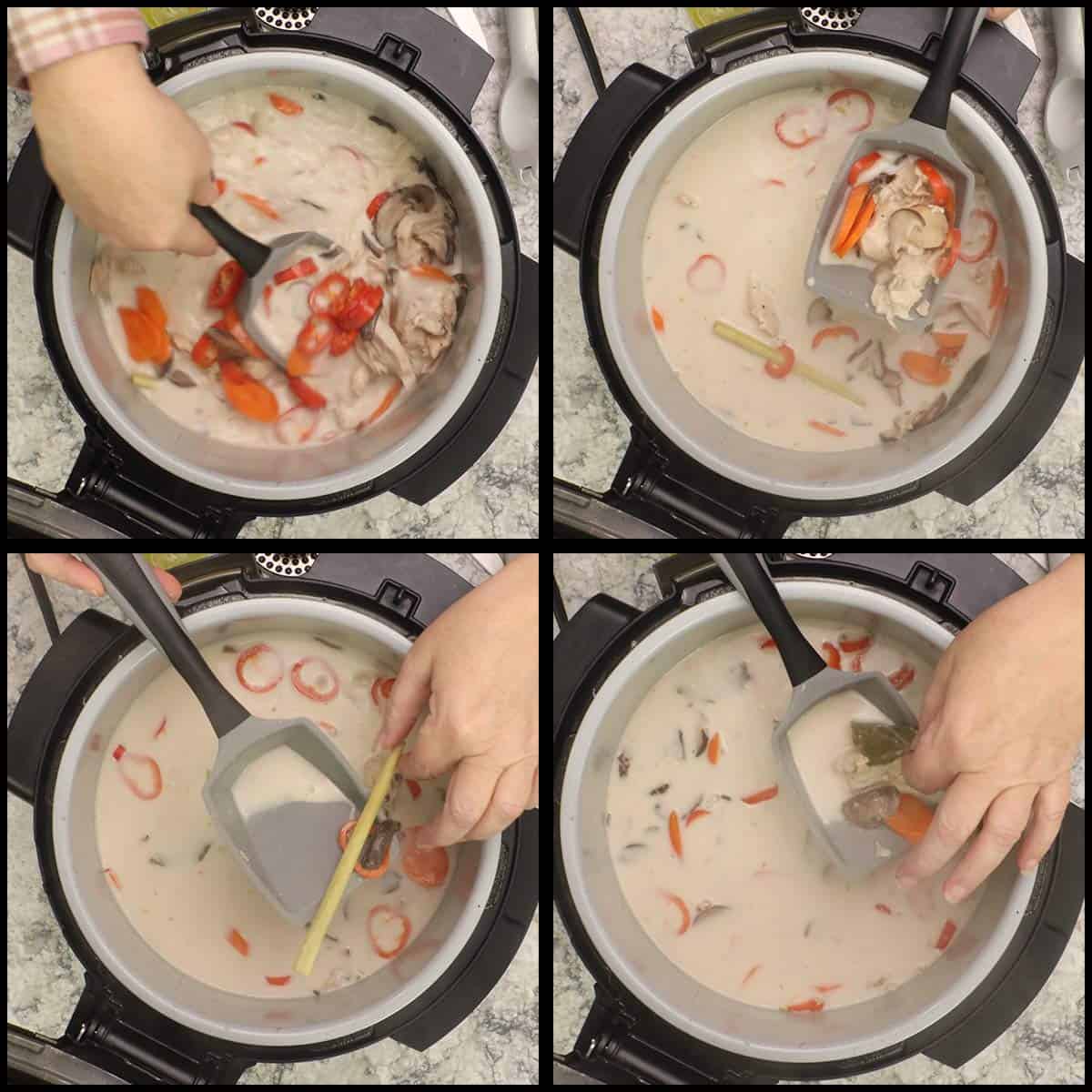
Just before serving, add whatever garnishes you like. Some great options are; chopped green onions, thai basil, chopped cilantro.
I have also added a few handfuls of fresh baby spinach at the very end if I have it on hand and need to use it up. It looks beautiful in the soup.
If you don't want spinach or any of the garnishes in all of the soup, you can also add a handful of fresh spinach to a bowl and ladle the hot soup over it, then top with any other garnishes you like.
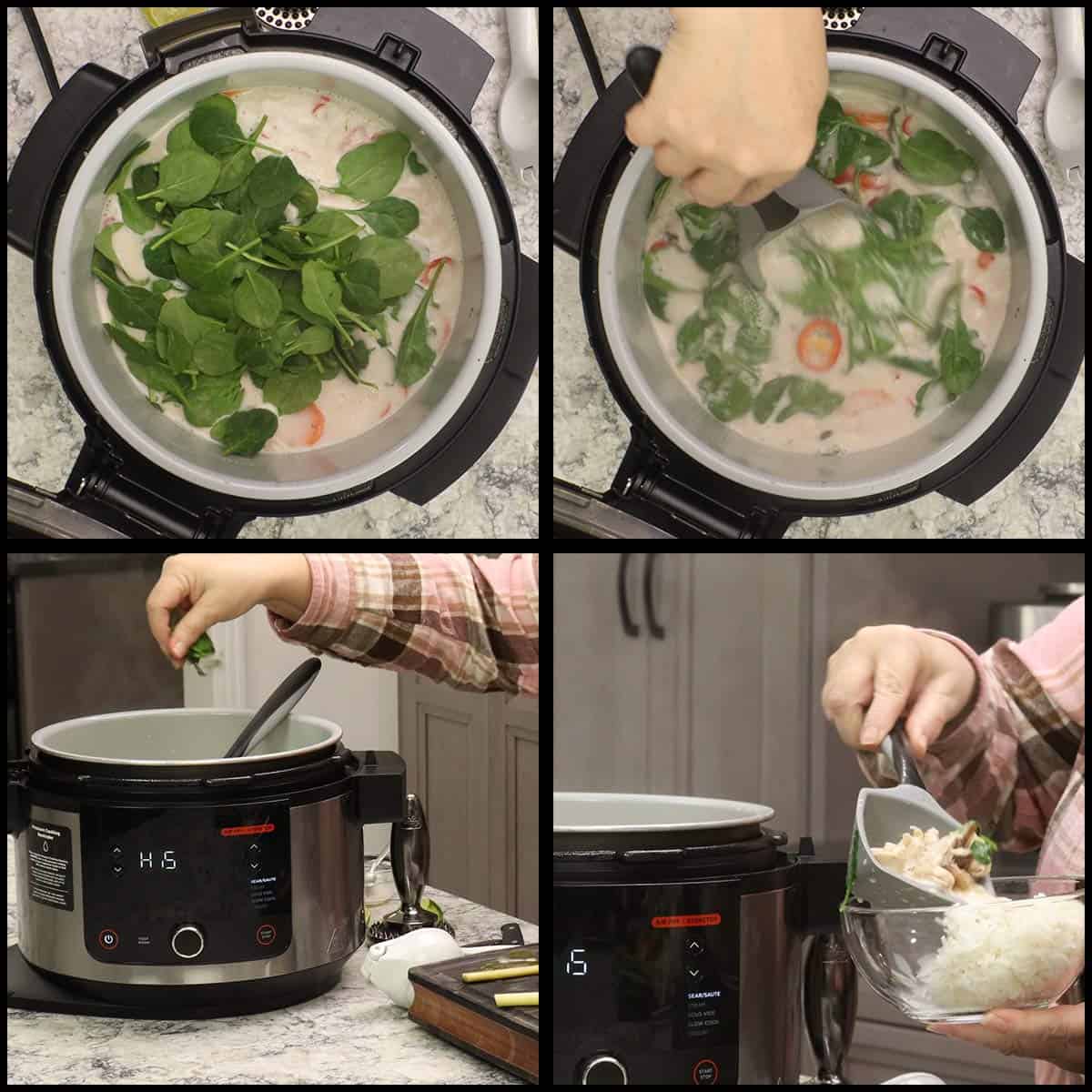
Serve the soup with jasmine rice or try it with rice noodles!
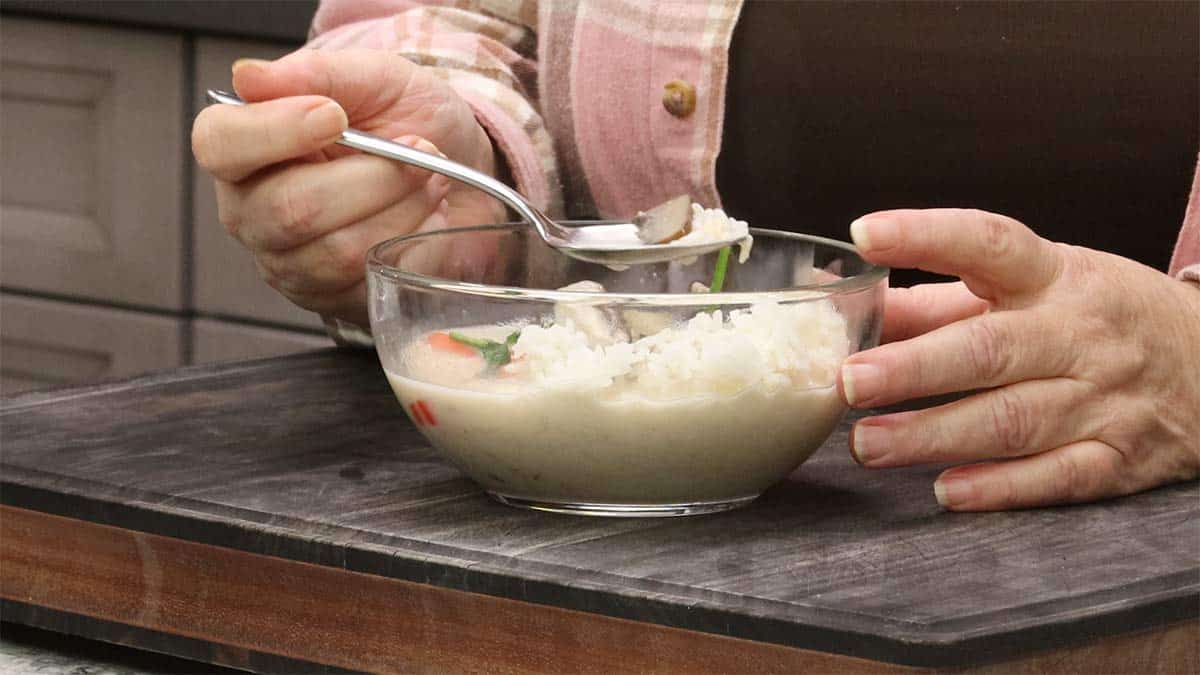
Stove Top Coconut Chicken Soup Directions
The ingredients are the same when using this method as they are for the pressure cooking method.
Add the following ingredients to a large pot on the stove.
- chicken broth
- fish sauce
- Thai chili peppers and chili garlic sauce if using
- chunks of galangal
- lemongrass stalks or lemongrass paste
- kaffir lime leaves
- sliced mushrooms
- sliced chicken
- salt
Bring the ingredients to a boil over medium high heat and then immediately reduce the heat to medium or medium low to maintain a simmer.
Simmer for about 30 minutes or until the chicken is cooked through. Add the coconut milk, lime zest, lime juice, and any other vegetables you want to add to the soup. Simmer on low for at least 10 more minutes or until the vegetables are cooked the way you like them.
Garnish as desired and serve!
Storage & Reheating Instructions
How to Store Leftover Coconut Chicken Soup
Coconut Chicken Soup can be stored in the refrigerator for up to 3 days or in the freezer for up to 6 months when packaged correctly.
Refrigeration
Place any leftover soup into airtight containers.
I recommend keeping the rice separate from the soup if you have both leftover because the rice will absorb the liquid from the soup and become soggy and fall apart, changing the texture of the soup.
Do not be alarmed if your soup separates in the refrigerator, it does that! When you reaheat it, everything will come back together.
This is what my soup looked like after 24 hours of being in the fridge. You can see most of the coconut milk is on top. Not very appetizing, but it reheated perfectly fine!
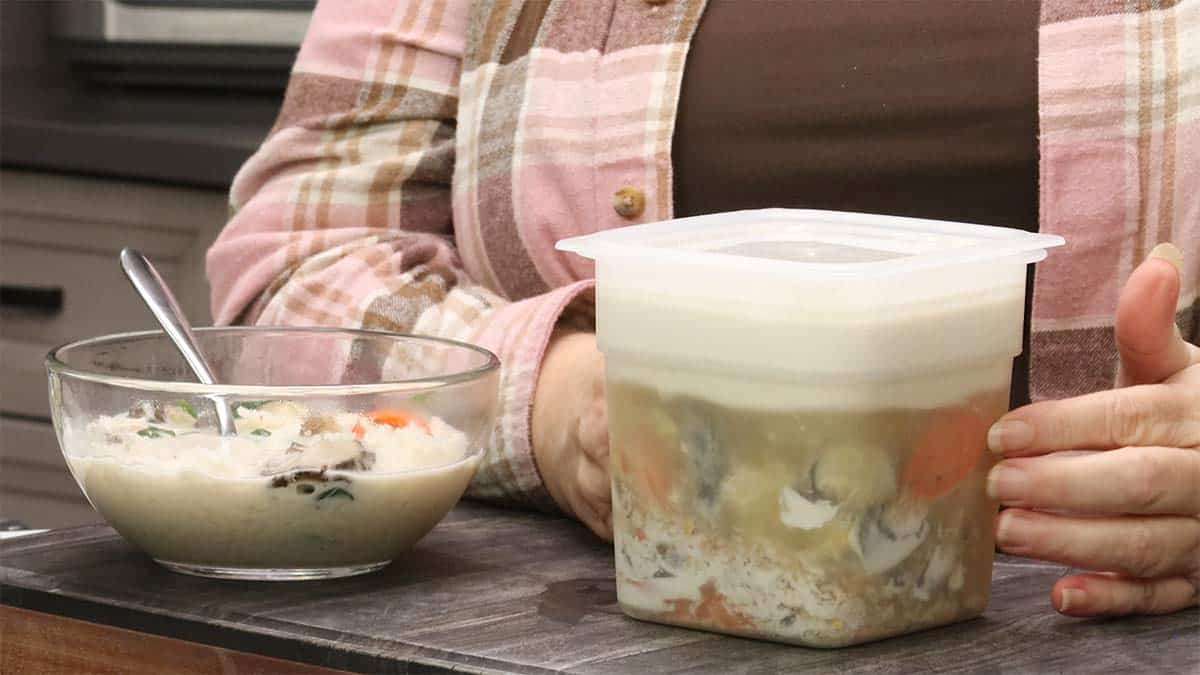
Freezer
Freezing liquid soups can be a little challenging when using freezer bags or a vacuum sealer.
Make sure the soup is cold before packaging for freezing. If the food is warm when packaged for freezing, steam can be produced inside the container or freezer bag, resulting in ice crystals forming.
Air is another issue when freezing food, so make sure you choose a container that is the proper size for the amount of leftovers. You don't want a 3-cup container for 1 cup of leftover soup or there will be too much air trapped in the container which can lead to decreased quality of the meat.
Freezer Bags
Ladle the soup into freezer bags and try to get as much air out as possible. Seal the bag and freeze flat.
Vacuum Sealer
I either use the pulse function on my vacuum sealer or sometimes I will bag up the soup and freeze it on a tray before sealing it.
Either way, you want to cut the bag about 3-4" longer than you need for the amount of soup you are freezing.
Lay the bag flat on the counter in front of the vacuum sealer and place the end into the sealer. Pulse seal until the soup reaches the vacuum sealer, but doesn't go all the way into the sealer. Press seal.
To freeze before sealing, fill the bag with soup leaving at least 3" of bag at the end. Fold the bag over the soup and lay it on a tray. Freeze the soup on the tray overnight.
When the soup is frozen, you can vacuum seal it without the liquid getting into the sealer and causing issues with the seal.
How to Reheat Coconut Chicken Soup
Ninja Foodi or Instant Pot
If the soup is refrigerated, the best way to reheat is either using sear/sauté on medium or you can use the slow cooker on low or high. Make sure to stir occasionally with either method.
The soup is ready when it is steamy and hot.
If the soup is frozen, I recommend using slow cook on high and the time will depend on the amount of soup, but usually it is ready in 60-90 minutes.
Stove Top
Place the cold leftovers in a pot and simmer on medium until heated through. When using the stovetop it is best to thaw frozen soup before reheating.
Frequently Asked Questions
Only if you want it to be.
The two ingredients that make the soup spicy are the Thai chili peppers and the chili garlic sauce. If you omit those, the soup will not be spicy.
You can also increase the level of spiciness by adding more of the peppers or chili garlic sauce.
Yes, you can increase or decrease the amount of soup by increasing or decreasing the amount of ingredients accordingly.
When pressure cooking, there isn't any change in time if you double or halve the ingredients. The only thing I would do differently if doubling the ingredients is to allow for a 10-minute natural pressure release so the contents of the soup have a change to cool down before you release the remaining pressure. This will avoid the soup from spewing out of the valve.
If you have never had this soup before, the best way to describe it is a creamy coconut broth with tender chicken slices and mushrooms that has a hint of citrus and spice if you use the chili peppers.
It is full of flavor and very satisfying.
What to serve with Coconut Chicken Soup
I usually serve it with jasmine rice in the bowl with the soup, but if you want to serve appetizers or another main entree with the soup, here are some ideas for inspiration!
- Air Fryer Crab Rangoon
- Asian Lettuce Wraps in the Ninja Foodi
- Asian Steamed Buns in the Ninja Foodi
- Ninja Foodi Recipe ~ Asian Sticky Wings
- Asian Steak with Stir Fry Veggies & Rice ~ Ninja Foodi 360 Meal
- Asian Turkey Meatballs
- Green Curry Chicken with Rice ~ One-Pot Meal in the Ninja Foodi
- Air Fryer Coconut Shrimp in the Ninja Foodi (or any Air Fryer)
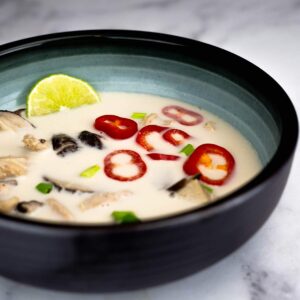
Coconut Chicken Soup Recipe (Tom Kha Gai))
Equipment
- Ninja Foodi Pressure Cooker or Instant Pot
Ingredients
- 4 cups chicken broth
- 4-6 kaffir Lime Leaves fresh, frozen, or dried
- 2-4 Thai chili peppers optional for spiciness
- 1-2 teaspoons chili garlic sauce optional for spiciness
- 4" galangal root chopped into chunks
- 2 stalks lemongrass or 1 Tablespoon of lemongrass paste
- 2 Tablespoons fish sauce
- 4 ounces sliced baby portobello mushrooms
- 4 ounces sliced shiitake mushrooms
- 1½ pounds chicken breast sliced thinly
- 2 teaspoons fine grind sea salt or kosher salt
- 2 cups coconut milk or one 13 ounce can is fine
- 1-2 limes zest and juice
- 1-2 carrots sliced (optional)
- 2-3 mini sweet red peppers sliced or a red bell pepper sliced (optional)
Optional Garnishes
- chopped cilantro
- Thai basil leaves
- Lime wedge or slice
Instructions
Pressure Cooker Instructions
- Add the chicken broth, kaffir lime leaves, chili peppers and chili garlic sauce (if using), chopped galangal, lemongrass, fish sauce, sliced mushrooms, sliced chicken, and salt to the inner pot of the Ninja Foodi or Instant Pot. Stir ingredients well.4 cups chicken broth, 4-6 kaffir Lime Leaves, 2-4 Thai chili peppers, 1-2 teaspoons chili garlic sauce, 4" galangal root, 2 stalks lemongrass, 2 Tablespoons fish sauce, 4 ounces sliced baby portobello mushrooms, 4 ounces sliced shiitake mushrooms, 1½ pounds chicken breast, 2 teaspoons fine grind sea salt or kosher salt
- Place the pressure lid on and turn the valve to seal. Select pressure cook on high and set the time for 2 minutes. When the time is up, immediately release the pressure. Open the lid and stir, breaking up any clumps of chicken.
- Add the coconut milk, zest and juice of 1-2 limes. Add carrots and sliced sweet red peppers if using and simmer on sear/sauté on medium heat for 5-10 minutes or until the carrots and peppers are cooked to your liking.2 cups coconut milk, 1-2 limes, 1-2 carrots, 2-3 mini sweet red peppers
- Stir and taste for seasonings. Add more chili garlic sauce if you want it spicier. Add chopped cilantro, green onions, and Thai basil as desired. Serve with Jasmine rice and lime wedges. Enjoy!chopped cilantro, Thai basil leaves, Lime wedge or slice
Stovetop Directions
- Add the chicken broth, lime leaves, chili peppers and chili garlic sauce, lemongrass, galangal, fish sauce, mushrooms, chicken and salt to a large pot. Bring to a boil and then immediately reduce the heat so the soup is simmering. Simmer for 30 minutes or until the flavors have infused and the chicken is cooked.
- Add the coconut milk, lime zest and juice. Stir. Add additional veggies if using and simmer until they are cooked to your liking. Garnish and serve with jasmine rice. Enjoy!
Notes
Nutrition
ABOUT THE RECIPE AUTHOR, LOUISE LONG
Louise is a full-time recipe creator and food blogger @ The Salted Pepper. She has over 30 years of experience with cooking and recipe development. She owned a restaurant for several years and was a full-time RN until retiring to blog full-time.

She published her first cookbook in the Fall of 2018 and is very interested in writing several more.
Louise is also the creator of an online Ninja Foodi Pressure Cooking Course with over 100 instructional step-by-step videos. People absolutely rave about the course and all the value they have received from it.
Louise has several very active Facebook groups that help people with the basics of cooking and getting the most out of the Ninja Foodi.
Louise is also a YouTube creator and you can find most of her recipes in video format on The Salted Pepper YouTube channel.
She is very responsive to messages and eager to help in any way she can. Get more Information about Louise & contact information
I WOULD LOVE TO SEE WHAT YOU ARE COOKING UP IN YOUR KITCHEN! TAG ME @THESALTEDPEPPER ON YOUR FAVORITE SOCIAL MEDIA PLATFORM WHEN YOU MAKE A DISH!
BE SURE TO FOLLOW THE SALTED PEPPER RIGHT HERE ⇓⇓⇓⇓⇓


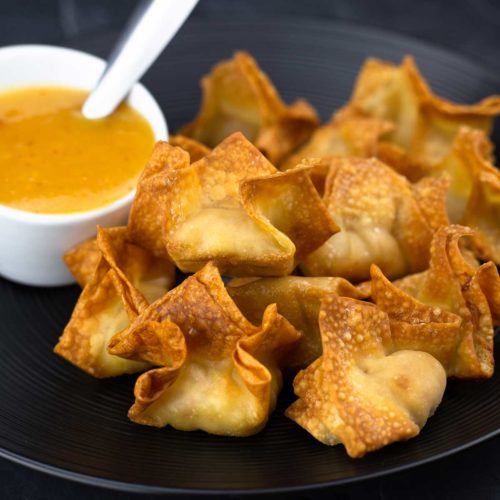
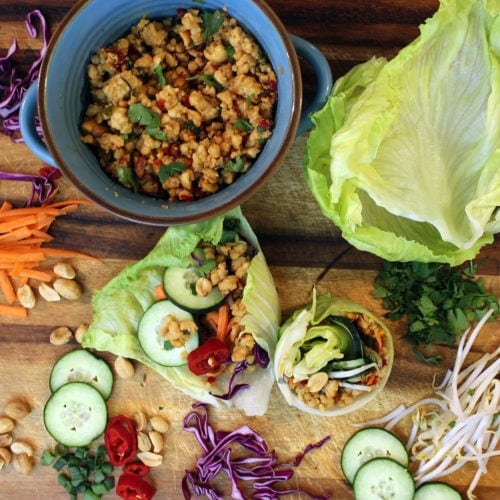
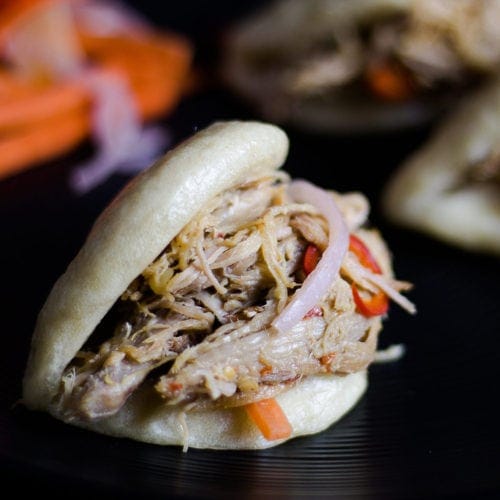
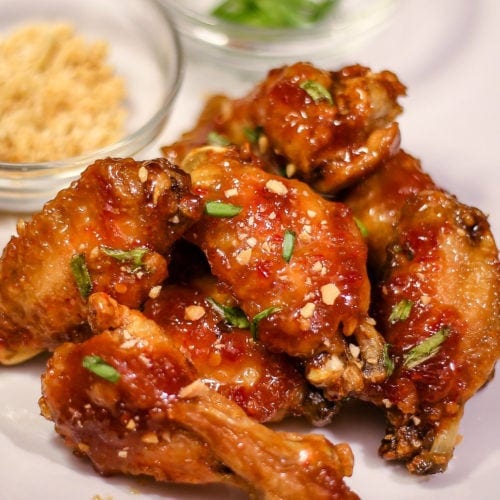
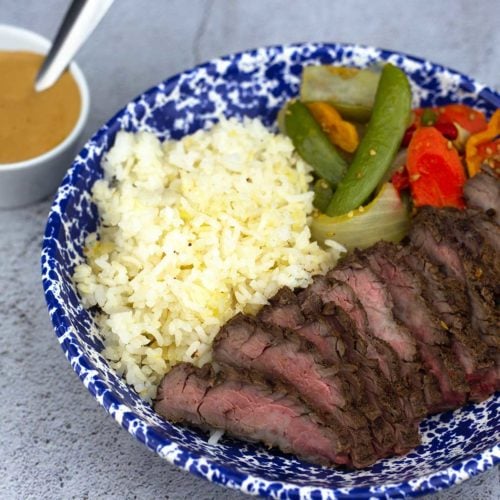
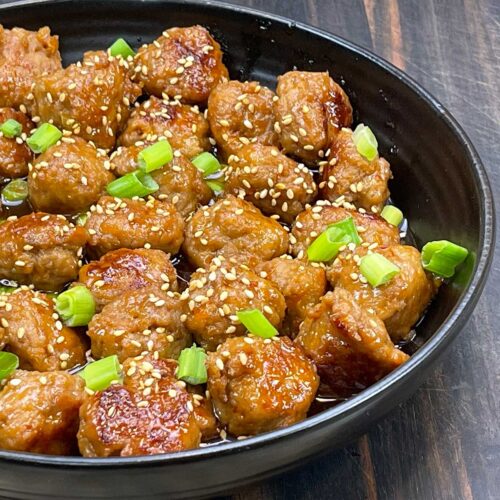
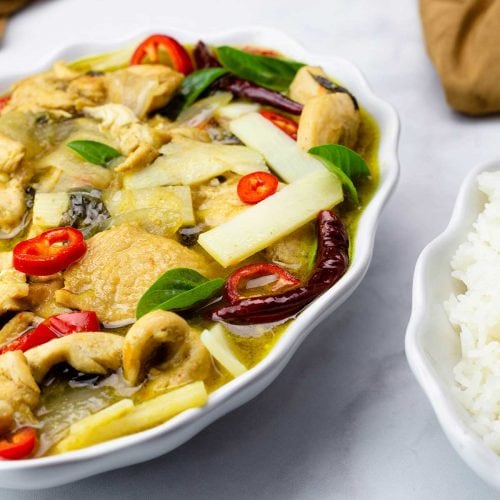
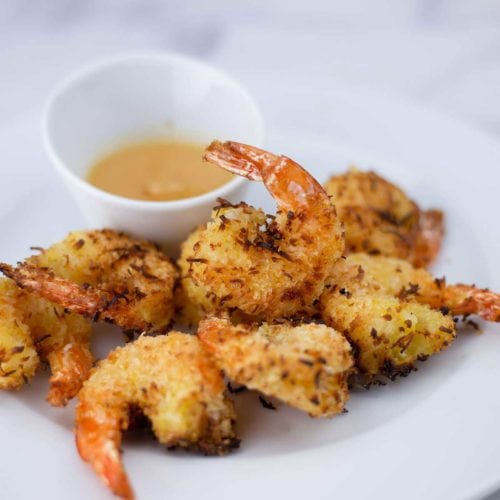
Elbridge Price
This soup was beyond excellent! Other adjectives that come to mind include awesome, sublime, fantastic, just to name a few. In addition to red bell peppers, I added orange and yellow. I opted to not incorporate spices and those spices weren’t missed. Thanks could not find kaffir lime leaves and the garangula (spelling?) root. And I used lemongrass paste as that was all I could find. I decided to add a teaspoon of ground ginger which worked well.l used my Ninja OL601 PC and followed the directions. Used fresh boneless skinless chicken breast tenders….. 1.4 pounds. This was great soup. Some small quibbles: The color wasn‘t creamy white as in the photo. Just sort of whitish. When I make it again, I’ll for sure double it because I didn’t get enough soup. The soup was just superlative!
Louise
I'm so glad you enjoyed it! I had the same issue with the color when I first started making it and I switched to cartoned coconut milk (Brand: Aryo-D) and that worked like magic!